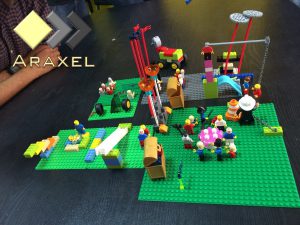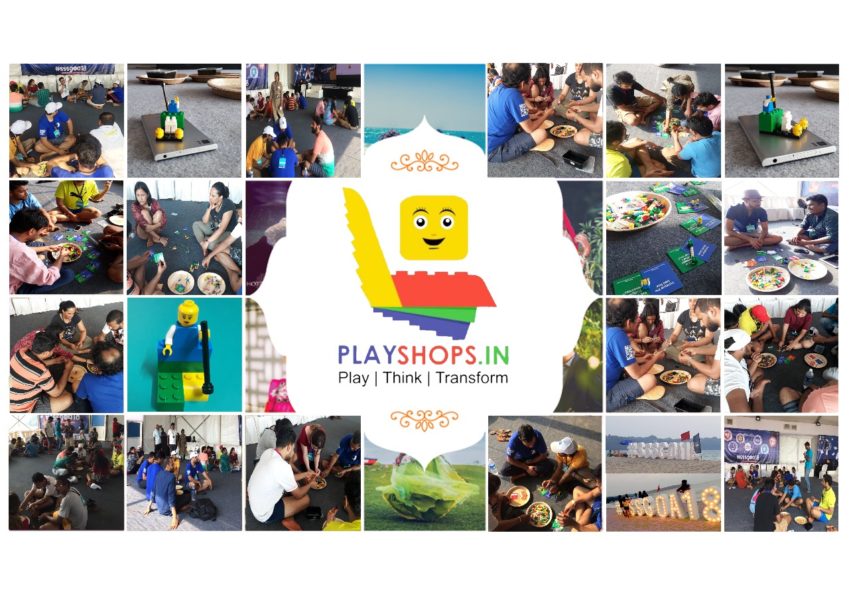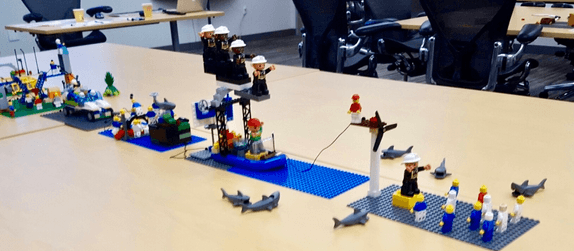Here is an interesting attempt to define play In short the author defines it as “the recognised, negotiated, process of a purposeful shift in the dominant meaning; and contextual attribution of value, of acts”
The rest of the blog is really about expanding and explaining the definition.
I found it an interesting read, it differs somewhat from the definition we (The Association of Master Trainers) work with, but it points nicely to some important elements of play, eg the “fluidity” of meaning and value. The weakness is that it comes across as very anchored in sports and (finite) games. This might also be why the author does does not go into why we play and the impact of play
I’ve never been fully satisfied with the definitions of ‘play’ and ‘game’ that have currency in Game Studies. Where I really have trouble is when I try to apply them to the fields of ethics and the philosophy of law in which I now tend to write.
In my recent analysis of sports law and the historical relationships between violence, criminal law and governance (focusing on duelling, boxing, rugby etc) I’ve been searching for an explanation of what is going on when sport is left to get on with it – free from ‘magisterial interference’, as the London Prize Ring Rules of 1838 put it.
I’ve touched on some of this in a recent post (People play online http://terranova.blogs.com/terra_nova/2011/02/people-play-online-.html) – but what I did not focus on there was a more formal characterisation of the thing at the centre of sport and games i.e. play.
Since Huizinga’s Homo Ludens (1938) there has been a modern academic debate about the meaning of ‘game’ and ‘play’. Readers not familiar with the history can quickly get up to speed by reading Juul’s excellent paper The Game, the Player, the World: Looking for a Heart of Gameness (http://www.jesperjuul.net/text/gameplayerworld/), and Malaby’s Beyond Play: A new Approach to Games (http://papers.ssrn.com/sol3/papers.cfm?abstract_id=922456).
The cannon of theories all do useful jobs of work, however I feel that none of them successfully identified the correct underlying principles at the heart of play, or at the very least those that are operational when we look at play in respect of law and other forms of institutional power.
It seems to me that one core concept that explains what play is and how it operates should be founded on what’s happening at the semiotic layer. So let’s jump into my proposed definition (that will need a lot of un-packing):
Play is the recognised, negotiated, process of a purposeful shift in the dominant meaning; and contextual attribution of value, of acts.
Games are normative forms of play.
[28 Feb 11 ludic] play-meaning – the meaning that has been shifted or attributed
[28 Feb 11 ludic] play-semiotics – the system of the signs product through play
ludic-capital – the degree to which these ludic-meaning and semiotics are operational in a given context e.g. when set against institutional-capital.
[edit 26 Feb 2011:
ludic-intent – the intentional attitude we hold towards acts where the internal meaning and value we attribute to them has primacy over external ones.
ostensible-play or hollow-play – where the intentional attitude that we hold towards acts holds the external value of those acts over the internal values and meanings]
Magic circle – the term we use to denote the bounds of the context wherein the ludic-meaning of an act prevails over the co-existing non-ludic meaning (or lack thereof).
OK, let’s un-box that…
Act
I’m being broad in my use of the word act. I don’t just mean physical things but also, speech, thoughts etc. So I’m including word games and purely cognitive forms of play.
Meaning shifts and recognition
Where I’ve always started puzzling about play is by wondering what it is I recognize when I see play occurring, and how it is that this thing seems to have so much power. Back to my favourite example – in the normal course of events we don’t arrest boxers or rugby players for Battery. So what is it that they are doing that is not the same as people hitting or pushing each other?
Of course, as I covered recently on TN, they are ‘doing’ anything different at all. Rather they, the officials, the sporting bodies, the law, spectators and many that might just happen to see the event attribute a different meaning to the acts.
Moreover, in sport a lot of socio-cultural signalling work goes into pointing out that the acts in question signify something other than we might expect. Language is an important sign – we tend not to talk about rugby players pushing each other, we talk about blocks and tackles. In boxing we talk about jabs and under-cuts. Visual signs are also important – people are wearing unusual clothes, usual ones that are different from ‘ordinary’ ones, they in a marked space during a marked period of time.
What all this is doing is facilitating all relevant parties’ recognition of the meaning shift. Indeed, a more systematic analyses might reveal that there is a correlation between the strength of signalling and gap difference between the juxtaposed meanings i.e. physical contact sports require a lot of signals so we are very sure that they are not ‘just at fight’, whereas playing-field cricket with a tennis ball needs very few signs to protect it form external influence as the what’s at stake when ludic-capital fails to have force are very low.
I also want to note here that ‘recognized’ entails at lest some degree of being ‘conscious of’ – I will pick this point up more in the discussion of ‘purposeful’.
Negotiated process
Factors that are characteristic of the spectrum from free solo play to international sport are the parameters and processes of meaning negotiation.
In solo free play we create meaning: ‘this box is a castle, the cushions are my army, apart from that one I can’t reach, that’s just a cushion’ – here play involves the process of self negotiation of the signs we are attributing to artefacts, thoughts or acts. Knocking something all the way over with a ball might signify that it has been defeated, unless it falls against the sofa and does not fall over – then maybe it is defeated, or maybe it’s just injured and needs another strike to be defeated, maybe that will change in a few minutes etc etc etc.
When two or more people are involved in play they jointly consent to shift meaning and mutually give respect to the shifted meanings through the process described here. This may be a highly formal process involving actual contracts or unspoken and just understood through action. This mutuality is not perfect as the meanings somewhat internal to each individual. This is not a weakness in play or this proposed theory of play – it is an intrinsic characteristic and why negotiation is also intrinsic. Learning this is part of learning how to play.
Hence – when I mention shifted meaning or mutually understood meaning in a play involving more than one person, strictly speaking I’m allowing for non-perfect symmetry of meaning and negotiation processes (but that’s a bit long winded to keep repeating).
So, in some forms of play a sphere is play artefact that should be held or kicked in specific ways, and that getting it through hoop scores a point, and a point is valued more than not-a-point, and that if the ball goes into the road play stops for a while and there’s no advantage to either side because the road is dangerous, so the fact that getting the sphere might be dangerous often prevails over it being a ball (though of course not all the time – an area that’s particularly interesting when we think of injury and liability in ARGs and games that utilise the built environment).
This goes all the way to tacking someone in a game of rugby which can only be done in a certain way, too near to the head and it’s not a tackle, it’s ludic-meaning gives way to it’s non-ludic one: it’s an attack, or at least there will be some form of negation over the dominant meaning – ranging from unspoken thoughts and looks thought to court cases. For American readers – the NFL have recently re-interpreted what are “egregious and elevated hits”, issuing fines to those that fell foul of the new rules (http://www.nfl.com/news/story/09000d5d81b732df/article/anderson-on-flagrant-hits-no-new-rules-just-more-enforcement).
Dominant meaning
So, the process of negotiation is one of establishing which meaning; among many possibilities, is the dominant meeting to be attributed to a given type and token of act. In games and sport where this is well established, the emphasis of negotiation is in on whether individual acts fall within the parameters mutually agreed for the given type of act.
It is critical to note that the dominant meaning of an act for any given person or institution co-exists with other meanings, both those that are produced through play e.g. ‘I thought the ball was out if it was on the line’; and those that pre-existed e.g. ‘the man hit the other man’. The meanings given primacy and dominance through play exist in a complex, sometimes co-constructive, relationship to these other meanings. A relationship that can shift over time for any given act – see below for a little more on this.
Attribution where non existed
By ‘shift in meaning’ I include both: a shift from a previously understood meaning to a new one; and, a shift form there being no previous meaning, or an extremely diverse set, to a new mutually recognized. For example a sphere going through a hoop or between piece of wood tends to have no generally understood meaning – but in many games a very central and important mean is attributed to it.
Purposeful
As noted above the recognition of meaning shift implies that there is some consciousness of the process that is occurring. More than this, the process of meaning shift does not just happen to be occurring, people are actively doing it. So, to be playing you have to know you are playing – you can involve other people, such as in many Alternative Reality Games, but they them selves are not players unless they gain awareness of the game.
One of boundaries of my proposed definition is probably animal play and play in early childhood, as here I’m not sure what should be said about the nature of recognition or purpose as this gets into theories of self consciousness. I’ll probably defer to Winnicott here (http://en.wikipedia.org/wiki/Winnicott).
Dominant .. contextual attribution of valuation
Meaning and value are inter-twined, but in defining play it is worth recognizing what is happening to each. I’ve covered meaning so now let’s look at value.
Contextual attribution is where we are giving primacy to the internal value of an act rather than the externalities. Like with meaning, both exist and may be recognized, but are not on equal footing. So, running with a ball and kicking it though a net have the contextual values of being a goal, changing the score and determining which team may win. They may also keep one fit, make on happy, earning a living etc. Indeed these may be a motivation to play, but they are contingent to what play is.
This is important because there are things that look very much like play but are not play. For instance getting on a bus and taking a bit of paper from a bus conductor has many characteristics of play: the conductor wears a uniform, they give you a bit of paper you both call a ‘ticket’, the ticket has meaning within the context of the bus journey etc. However, in this case the value of the meaning shift (e.g. from bit of paper to ticket) is primarily instrumental, whereas one might play a game of collecting the very same tickets and seeing how many of what colour ink one could get.
What’s not in the definition?
The definition of play and game I’m proposing is one that characterises a process. This is because, like some others, I think there are attributes that are very often products of play or generally associated with it that are not themselves intrinsic to it.
One issue with many definitions of play is that they sought to draw a bright line between play and not play. This definition tries not to do that. The shift and primacy of meaning and value is to a dominant role. One thing that is important about this distinction is that the other meanings and values do not go away. A push in rugby is still a push – it’s just that in many contexts it makes very little sense (but still some sense) to try to give primacy to that interpretation (see Peter Ludlow’s From Sherlock and Buffy to Klingon and Norrathian Platinum Pieces: Pretense, Contextalism, and the Myth of Fiction for more on this kind of thing in a philosophy of language style http://alphavilleherald.com/images/various/Fiction.rtf).
From another perspective it is worth nothing that under this definition, play is a process that co-exists with many other things. We may be playing world of Warcraft at the same time that we are talking on the phone or doing our day-to-day job, but the meaning shift that is going on in respect of pixels and xp is still occurring.
That is play is something that when doing we are also not doing.
We can be playing and thinking about our tax return, which is not play. So the dominance of meaning, or the ludic-capital of play, is not absolute. In the case of a sport, especially highly organized sport, ludic-capital tends to be fairly well signalled and bounded in space and time. Though there are still areas ripe for negotiation e.g. the player that hits another player just after the final whistle – the type of case where the lack of an absolute notion is clear as the socially constructed understanding of the act and the relative power of institutional v. ludic capital will determine which meaning prevails, till the case goes to appeal…
Dear Thomas
And this all ways brings my back to a conversation I’ve been having for years with the esteemed Dr Malaby, see:
- http://terranova.blogs.com/terra_nova/2006/08/against_excepti.html
- http://terranova.blogs.com/terra_nova/2006/11/games_meaning_a.html
- http://terranova.blogs.com/terra_nova/2007/11/what-do-we-mean.html
Thomas and I agree on a lot of things. In particularly Malaby explicitly resists the notion of play as a exception and thinks of it as process. Initially I thought that adding ludic intentionality to Malaby’s definition would make it fit for purpose, but that felt wrong as the notion of ludic is part of what one is trying to define. What’s more I feel that the focus on ‘contingency’ is useful, but meaning is where the action is at.
Putting the definition to work
I’m now going to apply the definition I’ve proposed to a set of related concepts and debates about play. Given the space I’ve already taken up this is going to be really superficial but will indicate the direction in which I’m thinking and the way I apply the theory – of course, you might buy it but apply it completely differently. I kinda hope you do.
Game
The definition of play that I’ve proposed includes the idea of value. I believe that games and sport are forms of play. Hence in the discussion above I have tended to move between them in the examples given.
As asserted above: Games are normative forms of play. What I mean by this is that in what one might dangerously term pure-play the values that are given to meaning have significance in respect to the in-play and not-play contexts but much less significance, in terms of ranking, in respect of each other. In games the relative value of meanings within the context of play are very important. So the difference between the ball going through the hoop and not going through it is characteristic of a form of game. That is, the norms in question that are the defining characteristic between play and game are internal to the game. It may be, and very often is the case, that these norms gain external recognition (indeed I’ve argued that they can become moral norms: MMO’s as Practices: http://www.mendeley.com/research/mmos-as-practices/) but that’s not an intrinsic quality.
This tends to lead to codification in the form of rules and governance. But it is not, as some might argue, the rules that are important but the play norms that they codify. Similarly it’s not the outcome of a game, as such, that is an essential characteristic but the possibility of an outcome distinct from another. I realize I’m splitting hairs here.
Like most other things here this difference between play and game has its clear-cut cases but as a general matter is somewhat fluid as the relative normative value of something within play might ebb and flow, so we might just play within the context of a game and play might turn into a game, it’s all about emphasis and primacy at any given time.
Law
The definition of play I’m proposing stems from my long discussions about the notion of play and latterly my reading of sports law. Hence where it fits very well is in the area of law and ethics as both of these are, and can be seen to be when one examines the rhetoric, rooted in meaning – often played out in terms of metaphor.
Hence I think that the idea of social-cultural shifts that mean that certain meanings just don’t get traction in an institutional context does explain the mechanics of what is going on in sport and, what should go on in law and computer games (part of the subject of a book I’m currently working on with de Zwart and Humphries).
Play and Playful
There is a continuum from being playful to play. In playfulness the shifted meaning is only partially or fleetingly dominant or is merely a peer of other meanings, hence playfulness can be easy to shift in and out of.
Fun
The definition does not require play to be fun [edit 26 Feb 2011: see my comment here for clafrication that forced play is hollow-play or ostensible-play].
or even voluntary. Someone might be forced to play at gun-point a game that causes them physical pain. Take football as an example – in respect of the process, the thing they are doing would still meet all the criteria above, sphere as ball, points etc etc thought I can see an argument about dominance of externality in this special case.
Why do we play?
I don’t know. The definition I propose seeks only to provide what I think are the intrinsic characteristics of what play is. There are deep psychological and social reasons for why we play and how we play, I suggest readers look at Sutton Smith and others for these. I’m not sure my definition even helps understand these motivations, but I hope that my emphasis of meaning helps.
Why does play ‘work’ ?
Again, I don’t really know, but I do have some thoughts about why play and so-called gamification have an impact on efficiency out outcomes. Basically its about a change of focus and a the relationship between meaning shifting (making) and learning. But more of that in another post…
Why is play and learning so closely aligned?
Because operational knowledge of meanings is intrinsic to play and the process of negotiation of meaning is very intense knowledge work. There’s a lot more to be said here.
Can play be work?
Sure. [edit 26 Feb 2011: maybe]
Cheating
Under the definition I have proposed cheating becomes an act related to games which is a wilful corruption of meaning for an end that that simultaneously embraces and undermines the norms in operation. Cheating can be seen as one of the boundary conditions of game.
Narratology vs ludology
I don’t think there is any conflict between my proposed definition and these two ends of the spectrum of approaching play. Stories are engines for creating meaning as is play, they are deeply linked. There’s yet another paper in this I think.
Magic Circle
I believe this definition is compatible with a slightly re-defined notion of the magic circle. Critics of the magic circle seem to want to get rid of it in totality because, I think they see it as too absolute and rigid. I think we need to be less literal about Huizinga. As I’ve noted above play is co-existent with other activities this does not in any way reduce the fact of play nor the ludic-capital in respect of, say, institutional power. So the magic circle still seems a very good way of picking out a conceptual space in which play occurs and some of the characteristic of that space.
Conclusion
I submit that many other definitions of play have great value. I propose that the definition I have provided here has utility partially in the fields of law and ethics. To be less modest I hope I have picked out the intrinsic features of play that underlie previous definitions and thus have provided…. One definition to rule them all :)
This is starting to feel like most of a paper and the start of a book so I’ll be very interested in feedback.
[edit 28 Feb 2011
Much thanks to all those that referenced Goffman in their comments. While I was aware of Goffman and a vague notion of frames, well ‘contextual frames’ was what I had in mind, I had not gone back to source. Doing so was a frankly uneasy experience as I found from reading Goffman that my view of play is not only a bit like his, it’s uncannily like it – he uses pretty much the same logic, the same distinctions, the same examples. It was kinda freaky reading it. I came to the initial conclusion that while I still think my analysis is pretty darn clever given I’d not read anything like it, it might be that Goffman has said everything already, so it was pure re-invention on my part. This moved me from uneasy to positively queasy.
I’ve now read a good chunk of Goffman and a bit of secondary writing, and I’m hoping there are some Goffman (Goffmonians?) scholars around that can help me out.
First, let’s revise some Goff..
In text below I’m quoting from the following edition of Goffman’s 1974 work: Goffman, E., Frame analysis: An essay on the organization of experience, Northeastern University Press 1986.
Early on Goffman defines ‘frame’ as: “I assume that definitions of a situation are built up in accordance with principals of organization which govern events – at least social one – and our subjective involvement in them; frame is the word I use to ref to such of these basic elements as I am able to identify” (ibid pp. 10 -11)
Later he talks about a concept called ‘keying’ which he says come in 5 types (ibid pp. 46 – 77):
- Make-believe
- Contests
- Ceremony
- Technical re-doings
- Regroundings
Furthermore keying is defined as (ibid p.45)
“a. Systematic transformation of materials already meaningful…”
“b. Participants in the activity are meant to know and openly acknowledge that a systematic alteration is involved…”
“c. Cues will be available for establishing when the transformation is to begin and when it is to end”
“d. Keying is not restricted to events perceived within any particular class of perspectives”
“e. …fighting and playing around at checkers feels to be much the same sort of thing…”
Goffman also notes that the activities have a “an inward-looking experiential finality”, and participants might enter into a “meaningful universe sustained by the activity” which we might call a “realm’ or possibly ‘world” (ibid p. 46).
Lastly I want to note where Goffman talks about a given instances of keying when: “during any one occasion participants felt that a particular frame prevailed and could be sustained” (ibid p.54)
Bringing frames and keys (or keying) together Goffman starts to add a few more terms: “Given the possibility of a frame that incorporates keyings, it becomes convenient to think of each transformation as adding a layer… the innermost layering, wherein dramatic activity can be at play to engross the participant. The other is the outer most lamentation, the rim, of the frame, as it were, which tells us just what sort of stat in the real world the activity has, whatever the complexity of the inner lamentations” (ibid p. 82).
Some things to note later in the work are, that dealing with out of frame activities Goffman talks about participants ability to “dissattend” (ibid p.202) i.e. withdrawing attention and awareness (ibid).
Lastly I want to note the notion of Frame Breaking where an individual breaks out of what would be expected within a frame through activities including “Flooding” (ibid p. 350) such as ‘dissolving into laughter or tears” (ibid), this might break the fame not only for them but for others. Goffman also talks about a shifted key where a response creates a sort of feedback loop which and produce an “up keyed” and “down keyed” response. Downkeying being where a play or organized fight gets out of control, Upkeying where things take on a greater sense of unreality e.g. players might start to make larger and larger bets out of all sense of portion (ibid pp 359 – 366).
So, I defined play as “the recognised, negotiated, process of a purposeful shift in the dominant meaning; and contextual attribution of value, of acts.”
I think it would be fair for someone to conclude that I’ve done nothing more than provide an alterative definition of keying and cash things like ‘up keying’ out in very slightly different ways in the context of a limited range of frames i.e. those relating to play, sports etc.
However I don’t read my work as saying exactly the same as Goffman – this is where more knowledgeable scholars need to help me out. Where I see the difference is that in my notion of play I want to put the fluidity of meaning and value, and the continual negotiation of this as central to the theory. I certainly see that there is an overall frame or context in which the play is occurring and that this can be broken by spoil-sports (who break the frame). But the notion of frame, like the notion of magic-circle in the original seems to me to be too rigid to account for the nuance of individual actions and interactions. In a sense I don’t see negotiation as something that is happening just in edge cases and having a binary outcome of play or not-play, rather it seems to me that the process of negotiation is one of the things that is sustaining and re-configuring play at each instant.
But, does anyone read Goffman as saying pretty much the same thing and I’m merely trying to save face (see what I did there) or thinking of the rigidity of frames in the physical world and carrying this over conceptually?]








 Become a LEGO Serious Play facilitator - check one of the upcoming training events!
Become a LEGO Serious Play facilitator - check one of the upcoming training events!
I am a big fan of play. And I recommend Stuart Brown’s book on the subject, appropriately titled, Play. Brown is reluctant to define play “because it is a thing of beauty best appreciated by experiencing it.” Nonetheless, he outlines the properties of play as having apparent purposelessness (done for its own sake; not for survival value) is voluntary (not imposed or required), has inherent attraction (it’s fun), provides freedom from time (we lose a sense of the passage of time), instills a diminished consciousness of self (we don’t think about our thinking and we don’t care if we look good or foolish, smart or stupid), has improvisational potential (opens us up to serendipity, allows us to explore new behaviors, thoughts, and strategies; and allows fresh insights to arise within us), lastly play provides a continuation desire (we don’t want the pleasure of play to stop, and when it does we look forward to engaging in it again). In summation, play is the essence of freedom, a release from the constraints of our self conscious world; play is its own reward, its own reason for being.
hi Per,
it is indeed a great book (and I believe a book that also Marko has recommend on this site). Personally, I have also quoted in a couple of articles and blogs. I really like his notion about how it helps “prepare” us for ambiguity